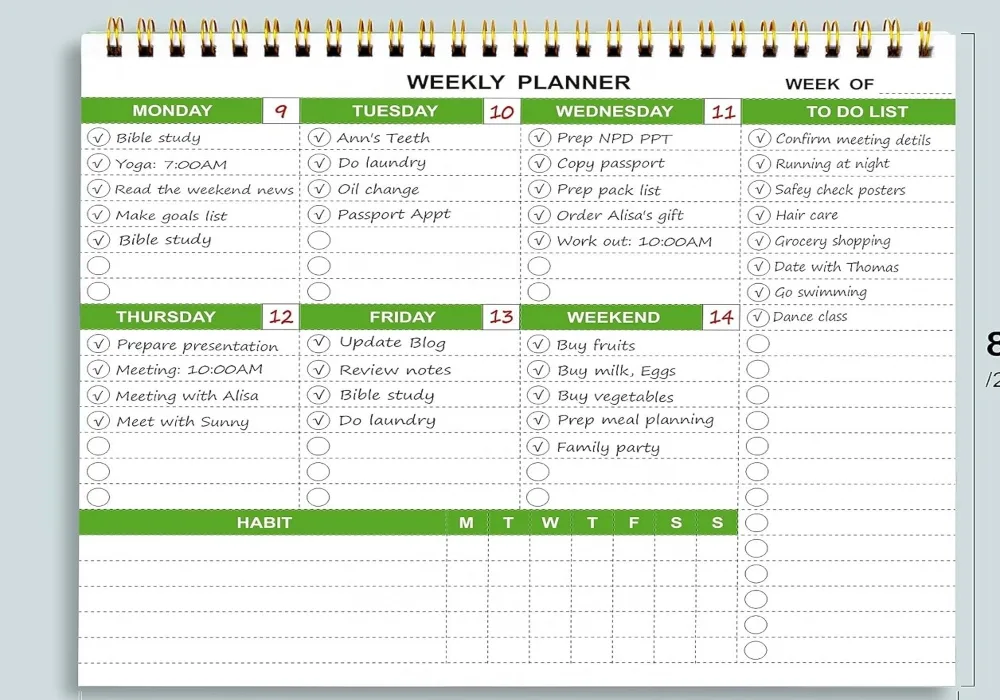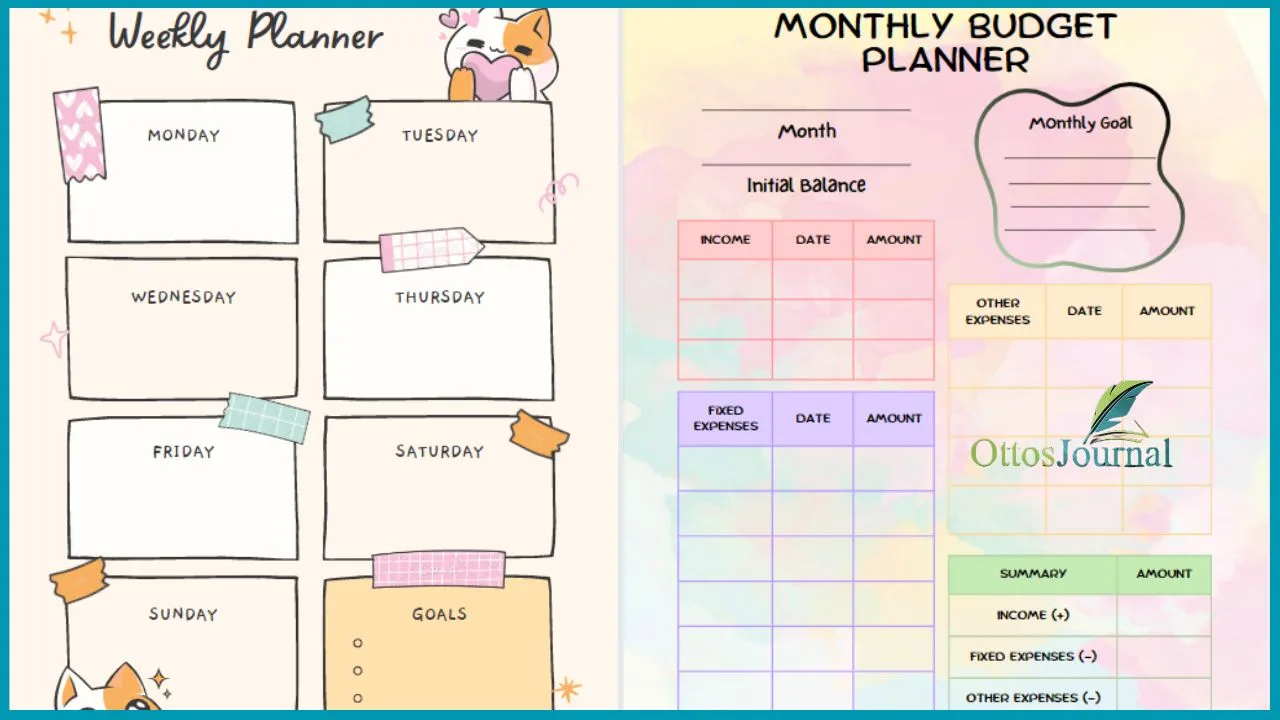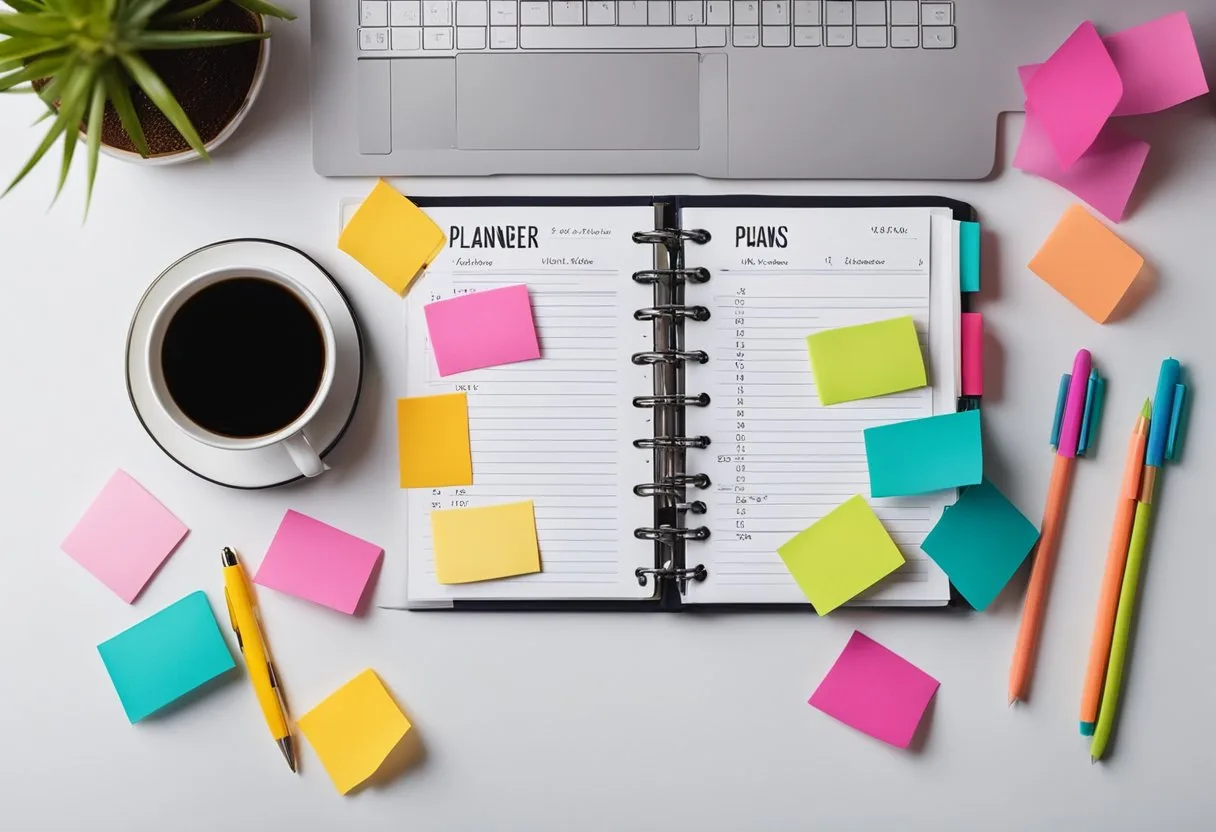Goal planning is an essential aspect of achieving success in any area of life. Whether it’s personal or professional, setting goals and working towards them can help individuals stay motivated and organized. However, it can be challenging to know where to start when it comes to goal planning. That’s where goal planner ideas come in. In this blog post, I will share with you 35 goal planner ideas to manage your goals effectively.
Goal planner ideas are tools and techniques that individuals can use to organize their goals and track their progress towards achieving them. These ideas can range from simple to complex, depending on an individual’s needs and preferences. Some popular goal planner ideas include creating a vision board, using a planner or journal, breaking down larger goals into smaller tasks, and setting deadlines for each task.
By using goal planner ideas, individuals can achieve their goals more efficiently and effectively. Goal planner ideas help individuals stay organized and focused, which can lead to increased productivity and motivation. Using a goal planner can help individuals identify potential obstacles and create a plan to overcome them, making it more likely that they will achieve their goals.
Choosing the Right Goal Planner
When it comes to choosing the right goal planner, there are several factors to consider. The following subsections will discuss the different options available and the features to look for in a goal planner.
Digital vs. Physical Planners
One of the first decisions to make is whether to use a digital or physical planner. Digital planners, such as apps and tools, offer convenience and accessibility, while physical planners offer a more tangible and customizable experience. It ultimately comes down to personal preference and working style. Some people prefer the traditional pen and paper approach, while others prefer the convenience of digital planners.
Free vs. Pro Versions
Another factor to consider is whether to use a free or pro version of a goal planner. Free versions may have limited features, while pro versions offer more customization and advanced features. It’s important to consider the specific needs and goals when deciding whether to invest in a pro version.
Features to Look For
When choosing a goal planner, it’s essential to look for specific features that align with the individual’s needs and goals. Some important features to consider include:
- Goal setting and tracking
- Task management
- Progress tracking
- Customizability
- Reminders and notifications
- Integration with other tools and apps
It’s important to prioritize the features that are most important and relevant to the individual’s goals and working style.
Choosing the right goal planner requires careful consideration of the individual’s needs and preferences. By considering the different options available and the features to look for, individuals can find a goal planner that helps them stay organized and achieve their goals.
35 Goal planner ideas
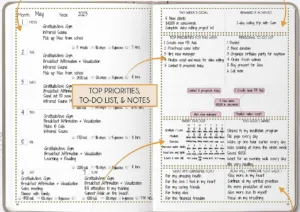
- Daily Gratitude Journal: Start by writing three things you’re grateful for each day to cultivate a positive mindset.
- Reading List: Create a list of books you want to read and start with scheduling a daily reading time.
- Fitness Goals: Set specific workout targets and begin with small, consistent workout sessions.
- Budget Tracker: Outline your expenses and savings goals, and initiate by tracking your daily spending.
- Skill Development: Choose a new skill to learn and kick off with online courses or tutorials.
- Travel Goals: List places you want to visit and start saving a small amount regularly for your travel fund.
- Professional Development: Identify career milestones and begin by updating your resume or LinkedIn profile.
- Nutrition Plan: Set healthy eating goals and start by planning your meals for the week.
- Meditation Schedule: Aim to meditate daily and start with just a few minutes each morning.
- Social Connections: Plan to reconnect with old friends and initiate by sending a message to one person a week.
- Volunteer Work: Decide on causes important to you and start by researching local opportunities.
- Language Learning: Pick a language to learn and start with basic vocabulary and phrases.
- Creative Projects: Plan an art or DIY project and start by gathering necessary materials.
- Home Organization: Set goals for decluttering and start with one small area at a time.
- Personal Reflection: Incorporate weekly reflection sessions and start by journaling your thoughts.
- Water Intake: Increase your daily water consumption and begin by carrying a refillable water bottle.
- Sleep Schedule: Aim for a consistent bedtime and start by setting a nightly alarm to wind down.
- Digital Detox: Plan regular breaks from electronics and start with designated tech-free hours.
- Mindfulness Practice: Integrate mindfulness into daily life and start with mindful breathing exercises.
- Networking Goals: Expand your professional network and begin by attending a local industry event.
- Investment Tracking: Set investment goals and start by reviewing your current portfolio.
- Hobby Time: Schedule regular time for hobbies and start by dedicating a small time slot weekly.
- Learning a Musical Instrument: Choose an instrument to learn and begin with basic scales or chords.
- Yoga Practice: Incorporate yoga into your routine and start with a beginner’s class or video.
- Cooking Skills: Aim to cook new recipes and start by trying one new recipe each week.
- Journaling: Start a daily journal and begin with writing a few lines every night.
- Time Management: Set goals for better time use and start by planning your day the night before.
- Sustainable Living: Plan to reduce your carbon footprint and start by using reusable bags and containers.
- Self-Care Routine: Develop a self-care plan and start with a short daily activity you enjoy.
- Financial Planning: Set long-term financial goals and begin with a review of your current financial status.
- Gardening: Plan to start a garden and begin with researching plants suitable for your climate.
- Public Speaking: Improve your speaking skills and start by joining a local speaking club.
- Writing Goals: Aim to write more, whether it’s a book or a blog, and start by writing a little each day.
- Running a Marathon: Set a goal to run a marathon and start with short, consistent runs.
- Mindset Shifts: Work on adopting a growth mindset and start by challenging negative thoughts with positive ones.
Setting and Tracking Goals in a Planner
![]()
Setting and tracking goals is an essential part of achieving success in any area of life. It provides direction and helps individuals stay focused on the tasks at hand. This section will explore the SMART Goals Framework, creating an action plan, and using trackers for progress monitoring.
SMART Goals Framework
The SMART Goals Framework is a widely used method for setting and achieving goals. It stands for Specific, Measurable, Achievable, Relevant, and Time-bound. Specific goals are clear and concise, while measurable goals have a quantifiable outcome. Achievable goals are realistic and attainable, while relevant goals align with an individual’s values and priorities. Finally, time-bound goals have a deadline for completion.
Creating an Action Plan
Creating an action plan is crucial for turning goals into reality. It involves breaking down a goal into smaller, more manageable tasks. These tasks should be specific, measurable, and time-bound. It is also essential to prioritize tasks based on their importance and urgency. By doing so, individuals can ensure they are making progress towards their goals.
Using Trackers for Progress Monitoring
Using trackers for progress monitoring is an effective way to stay on track and motivated. Trackers can be in the form of spreadsheets, apps, or journals. They allow individuals to monitor their progress and adjust their action plan accordingly. By tracking progress, individuals can celebrate their successes and identify areas for improvement.
Setting and tracking goals is a crucial component of achieving success. By using the SMART Goals Framework, creating an action plan, and using trackers for progress monitoring, individuals can stay focused and motivated towards achieving their goals.
Incorporating Wellness and Personal Development

When it comes to goal planning, it’s important to remember that wellness and personal development are crucial components of a happy and fulfilling life. Here are some ideas for incorporating these elements into your goal planner.
Health and Fitness Goals
Staying healthy and fit is an important goal for many people, and there are a variety of ways to incorporate health and fitness goals into your planner. Some examples include setting goals for daily exercise, tracking your water intake, or planning healthy meals for the week. You can also use your planner to track your progress towards larger fitness goals, such as running a marathon or completing a certain number of push-ups.
Personal Growth and Learning
Personal growth and learning are also important components of a fulfilling life. In your planner, you can set goals for learning new skills or taking on new challenges. For example, you might set a goal to read a certain number of books each month or to take a class in a subject that interests you. You can also use your planner to track your progress towards larger personal growth goals, such as improving your public speaking skills or learning a new language.
Mental Health and Reflection
Mental health and reflection are crucial components of overall well-being. In your planner, you can set goals for practicing self-care, such as taking time each day to meditate or journal. You can also use your planner to track your progress towards larger mental health goals, such as seeking therapy or practicing mindfulness. You can use your planner to reflect on your progress towards your goals and to identify areas where you may need to make adjustments or seek additional support.
By incorporating wellness and personal development goals into your planner, you can create a roadmap for a happy and fulfilling life. Remember to be specific and realistic when setting your goals, and to celebrate your progress along the way.
Budgeting and Financial Goals
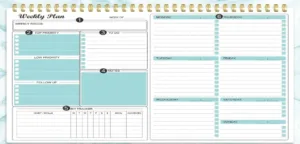
Setting financial goals is an essential aspect of personal finance management. It is crucial to have a clear idea of what you want to achieve financially and how you plan to achieve it. Creating a budget plan, using financial tracking tools, and investing in personal finance education are some of the ways to achieve your financial goals.
Creating a Budget Plan
A budget is a financial plan that outlines your income and expenses. It helps you track your spending and identify areas where you can cut back. Creating a budget plan is an effective way to achieve your financial goals. You can use free printable templates to create a budget plan that suits your needs. A budget plan can also help you plan your meal plan and save money on groceries.
Financial Tracking Tools
Financial tracking tools are essential for monitoring your spending and identifying areas where you can cut back. There are various financial tracking tools available, such as mobile apps and online tools. These tools can help you track your expenses, set financial goals, and monitor your progress. Some financial tracking tools also offer investment advice and financial education.
Investing in Personal Finance Education
Investing in personal finance education is an excellent way to achieve your financial goals. There are various ebooks and courses available that can help you improve your financial literacy. Personal finance education can help you understand the basics of budgeting, investing, and saving. It can also help you identify investment opportunities and avoid financial pitfalls.
Creating a budget plan, using financial tracking tools, and investing in personal finance education are essential steps to achieving your financial goals. By following these steps, you can take control of your finances and achieve financial stability.
Lifestyle and Hobby Planning
When it comes to goal planning, it’s important to consider not only professional and personal goals, but also lifestyle and hobby goals. These goals can help individuals maintain a well-rounded life and find joy in their leisure time.
Travel and Adventure Goals
Travel and adventure goals can range from exploring new cities to hiking a mountain to visiting a new country. Planning these goals can be a great way to ensure that individuals prioritize their desire for adventure and exploration. Travel and adventure goals can help individuals expand their cultural knowledge and create unforgettable memories.
To plan travel and adventure goals, individuals can create a list of destinations they want to visit, activities they want to try, and landmarks they want to see. They can also research travel deals and create a budget for their trips.
Hobby and Leisure Time
Hobby and leisure goals can include learning a new skill, trying a new hobby, or simply making time for a favorite activity. These goals can help individuals find joy in their leisure time and prioritize self-care.
To plan hobby and leisure goals, individuals can create a list of activities they want to try, research classes or workshops in their area, and create a schedule for practicing their hobbies.
Social and Relationship Building
Social and relationship goals can include making new friends, strengthening existing relationships, and building a support system. These goals can help individuals prioritize their social life and create meaningful connections with others.
To plan social and relationship goals, individuals can create a list of events they want to attend, activities they want to try with friends or partners, and ways they can show appreciation for their loved ones. They can also use social media to connect with others who share their interests or attend meetups in their area.
Lifestyle and hobby goals can help individuals maintain a well-rounded life and prioritize their desire for adventure, leisure time, and social connection. By planning these goals, individuals can find joy in their everyday life and create unforgettable memories.

Frequently Asked Questions
How can I effectively categorize my goals for better planning?
Categorizing goals can be helpful for better planning. One way to categorize goals is by using the “S.M.A.R.T.” framework, which stands for Specific, Measurable, Achievable, Relevant, and Time-bound. Another way to categorize goals is by dividing them into different areas of life, such as personal, career, health, and relationships. This can help in creating a more balanced and well-rounded set of goals.
Can you give examples of personal goals that align with common life aspirations?
Examples of personal goals that align with common life aspirations can include things like improving physical health, learning a new skill or language, traveling to a new place, or building stronger relationships with family and friends. These goals can be tailored to fit individual interests and desires, and should be specific, measurable, achievable, relevant, and time-bound.
What are the essential features of a SMART goal planner?
A SMART goal planner should have features that allow for the creation and tracking of goals that are specific, measurable, achievable, relevant, and time-bound. It should also include a way to break down larger goals into smaller, more manageable tasks, and provide a system for tracking progress and making adjustments as needed. It should be user-friendly and easy to navigate.
How should I structure a personal goal planner to track my progress?
A personal goal planner should be structured in a way that allows for the tracking of progress and the completion of tasks. One way to do this is by breaking down larger goals into smaller, more manageable tasks, and assigning deadlines for each one. It can also be helpful to include a system for tracking progress, such as a chart or graph, and to regularly review and adjust goals as needed.
What are some goal-setting strategies for business growth and development?
Goal-setting strategies for business growth and development can include things like identifying key performance indicators (KPIs), setting specific and measurable targets, creating a timeline for achieving goals, and regularly reviewing and adjusting goals as needed. It can also be helpful to involve team members in the goal-setting process, and to create a system for tracking progress and celebrating successes.
What types of goals are beneficial for students to focus on for academic and personal growth?
Goals that are beneficial for students to focus on for academic and personal growth can include things like improving study habits, developing time-management skills, building strong relationships with peers and mentors, and pursuing extracurricular activities or hobbies. These goals should be specific, measurable, achievable, relevant, and time-bound, and should be tailored to fit individual interests and needs.

